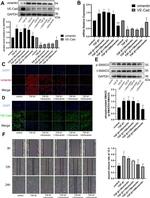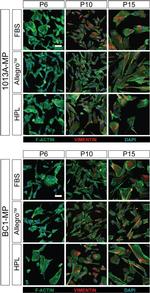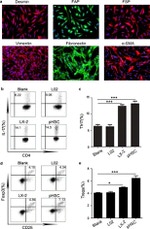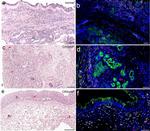Search Thermo Fisher Scientific
Invitrogen
Vimentin Monoclonal Antibody (V9), eFluor™ 615, eBioscience™
Product Details
42-9897-82
Species Reactivity
Published species
Host/Isotype
Recommended Isotype Control
Class
Type
Clone
Conjugate
Excitation/Emission Max
Form
Concentration
Purification
Storage buffer
Contains
Storage conditions
Shipping conditions
RRID
Product Specific Information
Description: The V9 monoclonal antibody recognizes human Vimentin, a 57 kDa protein that functions as a structural component of intermediate filaments. Vimentin is expressed in cells derived from the mesenchyme but also in specific populations such as radial glia and immature glial cells, as well as pancreatic precursor cells. It is proposed to be a marker of cardiac differentiation. In neural cells, vimentin expression is gradually replaced by neurofilaments. Reports have also shown surface expression of vimentin on activated macrophages, platelets, as well as apoptotic T cells and neutrophils.
This antibody also recognizes canine (dog), rat and chicken vimentin but does not recognize mouse vimentin.
Applications Reported: This V9 antibody has been reported for use in immunocytochemistry and immunohistochemical staining of frozen (IHC-F) and formalin-fixed paraffin embedded tissue sections (IHC-P).
Applications Tested: This V9 antibody has been tested by immunocytochemistry on fixed and permeabilized C6 cells at less than or equal to 1 µg/mL. It is recommended that this antibody be carefully titrated for optimal performance in the assay of interest. This product has not been validated for flow cytometric analysis.
Filter Recommendation: When using this eFluor® 615 antibody conjugate, we recommend a filter that will capture the 615 emission wavelength (for example, Excitation 560/55, 585LP, Emission 645/75). A standard Alexa Fluor® 594 filter is acceptable.
Excitation: 595 nm; Emission: 615 nm.
Filtration: 0.2 µm post-manufacturing filtered.
Target Information
Vimentin is a developmentally regulated intermediate filament protein (IFP) found in cells of mesenchymal origin. It is believed to be involved with the intracellular transport of proteins between the nucleus and plasma membrane. Unlike other IFP proteins, vimentin is expressed, along with desmin, during the early stages of cellular development. During the development process, vimentin is exchanged for new, tissue-specific IFPs. Vimentin has been implicated to be involved in the rate of steroid synthesis via its role as a storage network for steroidogenic cholesterol containing lipid droplets. Vimentin phosphorylation by a protein kinase causes the breakdown of intermediate filaments and activation of an ATP and myosin light chain dependent contractile event. This results in cytoskeletal changes that facilitate the interaction of the lipid droplets within mitochondria, and subsequent transport of cholesterol to the organelles leading to an increase in steroid synthesis.
For Research Use Only. Not for use in diagnostic procedures. Not for resale without express authorization.
Bioinformatics
Protein Aliases: epididymis luminal protein 113; FLJ36605; RP11-124N14.1; VIME; Vimentin; vimentin C-terminus
Gene Aliases: CTRCT30; HEL113; VIM
UniProt ID: (Human) P08670, (Dog) A0A8C0N8E3, (Rat) P31000
Entrez Gene ID: (Chicken) 420519, (Human) 7431, (Dog) 477991, (Rat) 81818

Performance Guarantee
If an Invitrogen™ antibody doesn't perform as described on our website or datasheet,we'll replace the product at no cost to you, or provide you with a credit for a future purchase.*
Learn more
We're here to help
Get expert recommendations for common problems or connect directly with an on staff expert for technical assistance related to applications, equipment and general product use.
Contact tech support








